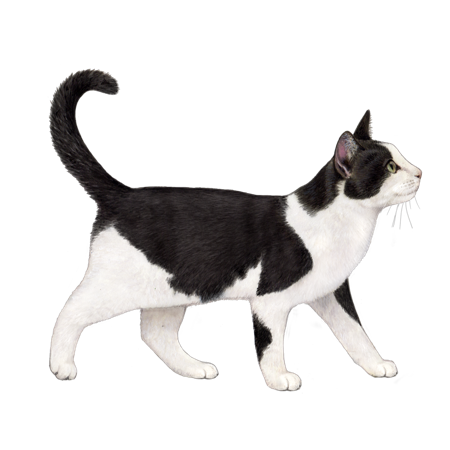
Cymric
Cymrics are intelligent, playful cats that show their people "dog-like" loyalty. They get along well with other pets and kids, and they're often the household clowns.
Interested in discovering if your cat is a Cymric?
Check out Wisdom Panel's DNA test.
Cymric Traits
General Appearance
Cymrics are medium-sized cats with an overall round appearance. They're heavy and muscular, with a well-balanced, compact structure.
Coat and Colouring
The Cymric's dense, medium-length double coat has a soft, silky texture and a glossy appearance. The hair on the breeches, stomach, and neck ruff is longer than that of the main body. Some Cymrics also have toe tufts and ear tufts. The breed comes in all coat colors and combinations and often displays dramatic markings.
Distinctive Physical Traits
Cymric have large, round heads and chubby cheeks. Their medium ears are wide at the base and taper slightly to a point. The color of their round, full eyes corresponds with their coat color. And their powerful back legs are much longer than their front—causing their rumps to sit noticeably higher than their shoulders.
If a cat has a full-length tail, they're called a "longie." If they have a nub or stump, they're called a "stumpie." Completely tailless cats go by "rumpie." And rumpies with a rise of bone at the end of their spine are called "risers."
Cymric Temperament
Cymrics are calm and social cats that make devoted family pets. They're very people-oriented and don't like being left alone for long periods. If your schedule takes you away from home for hours every day, consider getting your Cymric a "sibling" cat for company.
This intelligent breed can figure out how to open doors or cabinets if they think there is something of interest on the other side. They also have a sense of humor and have been known to play tricks on their humans. But most of the time, Cymrics are mellow, easy-going cats that like to follow their people around while chatting with their sweet, quiet voices.
With powerful hind legs, Cymrics can jump high, accelerate quickly, and perform rapid turns—all skills that make these kitties entertaining playmates. They love to chase, pounce, and play with interactive toys. These natural hunters will also guarantee their home never has a mouse problem.
Cymric History
The first known photograph of a tailless cat dates back to 1810. But other clues suggest they may have existed since as early as 1750.
Many fanciful legends attempt to explain why these cats are tailless. But the true story is simple: A genetic mutation caused kittens on the Isle of Man to be born without normal tails.
Because the gene that results in taillessness is dominant, it spread quickly among cats on the island. Occasionally, some were born with tails, which still happens today.
The population of tailless cats split into short and longhaired varieties. (The longhair gene was likely introduced during Viking rule—when ancestors of the Norwegian Forest Cat came to the island.) The shorthair cats, called Manx, received mainstream recognition long before the longhair Cymric. But both share the same breed standard.
Cymric Care
Nutrition
Cymrics require a high-quality diet to meet their nutritional needs. Because those needs vary for kittens, adults, and senior cats, opt for a formula that's age-appropriate for your pet.
To keep your cat at a healthy weight, measure out meals and reduce portions if necessary. And keep an eye on how many snacks you're giving them—just one ounce of cheese can account for half their recommended daily calories. As a guideline, treats should make up no more than 10% of a cat's caloric intake.
Lastly, all cats need access to fresh, clean water around the clock.
Grooming
Cymrics require weekly brushing to look their best. During periods of seasonal shedding, they may need even more frequent brushing.
Most cats' nails require monthly trimming to prevent them from getting too long. Long nails are more likely to snag on something and become torn or damaged. They can even grow into your cat's paw pads, leading to pain or infection. In addition to clipping, providing a scratching post will allow your cat to do some nail maintenance themselves (thanks to their instinct to scratch).
Good dental hygiene is essential to a Cymric's overall health. An ideal dental routine includes daily at-home teeth brushing combined with visits to the veterinarian for professional dental cleanings and exams.
Health
The genetic mutation that causes taillessness can also cause other health complications—including spinal cord or nerve damage, bladder or bowels problems, and digestive issues. Your veterinarian is your best resource for discussing these and other health concerns for your cat.
Breed Group
Western
The largest of breed groups, the Western Group is mainly comprised of cats developed in Europe and the Americas. Due to the complexity of feline genetic diversity, however, cat breeds from other regions may also be found associated with this group.
Resources
https://tica.org/breeds/browse-all-breeds?view=article&id=836:cymric-breed&catid=79
https://cfa.org/wp-content/uploads/2019/06/manx-standard.pdf
https://www.gccfcats.org/Cat-Breeds/Manx
https://tica.org/breeds/browse-all-breeds?view=article&id=836:cymric-breed&catid=79
Reviewed 23 February 2021 by Annette Louviere, DVM


























